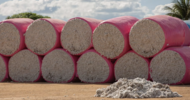World-Grain.com, June 01, 2009
by David McKee
There seems to be no end to the list of international cropland deals announced with increasing frequency beginning in 2008.
Saudi Arabia says it plans to invest $4.3 billion in Indonesian rice production. South Korea announces that it has been granted the right to develop 1.4 million hectares for maize and palm oil in Madagascar, half of the country’s arable land. Libya buys 250,000 hectares in Ukraine for wheat production. China acquires large farms in Africa, Russia and Latin America. United Arab Emirates purchases 324,000 hectares in Pakistan. Cambodia offers to sell Kuwait 800,000 hectares of idle land.
A recent study by the International Food Policy Research Institute (IFPRI) estimates that wealthy food importing countries have signed agreements to lease or buy 15 to 20 million hectares of cropland. This has mainly been in Africa and Southeast Asia, where much of the agricultural land is considered to be underdeveloped despite relative poverty and rapid population growth.
The Arab Gulf States and the three East Asian import powerhouses — China, South Korea and Japan — are most often the countries seeking control over foreign farmland. But many other countries seem to want to get into the game, ranging from India to Egypt to South Africa. Even northern European countries are making investments, but mainly for biofuels production and portfolio investments.
The spike in food prices during 2007 and 2008 triggered the current trend. But the anxiety of governments over food security is not just due to sharply higher commodity prices. Wealthy food deficit countries were scared even more by the cutoff or reduction of grain supply to international markets when traditional supplier countries like Russia, Ukraine, Kazakhstan, India and
Argentina imposed heavy export duties or outright bans on wheat exportation for a time. In the U.S., the diversion of maize to ethanol production and reduction in wheat acreage in favor of maize has also worried feed grain importers around the world.
Many of the foreign farmland acquisitions are being done by private companies, but it is sometimes government policy that is driving their activity. Saudi Arabia, for example, has created an $800 million fund called the King Abdullah Initiative for Saudi Agricultural Investment Abroad to finance overseas expansion by the kingdom’s agribusiness companies. Saudi companies have inked agreements to introduce large- scale mechanized grain production to both Sudan and Ethiopia on tracts of land provided by the governments of the host countries.
These projects are to take place while Saudi Arabia rapidly phases out its 30-year effort to grow 100% of its wheat requirement by tapping the country’s aquifers. The Saudis propose to introduce their modern wheat growing technology to the host countries where water is relatively abundant thanks to new dams. But they still require investment in irrigation systems. In this way, through a kind of global outsourcing, Saudi companies can control production of some of the kingdom’s 4 million tonnes of annual wheat consumption.
Most of the other Arab Gulf States are financing outward agricultural investment in the same manner.
GLOBAL DEBATE
Understandably, a global debate led by the media and international organizations is taking place about this new phenomenon in the global food supply chain. There are frequent cries of neo-colonialism and news headlines mentioning "foreign land grabs" or "Petro dollars versus Small-holders." Some bloggers note incipient similarities to the European carve up of the African continent in the 19th century. The thought of countries so associated with malnutrition, drought and famine shipping basic food commodities from giant farms to the wealthy nations who own the farms seems unpalatable to many people at first glance.
But many development experts point out that an inflow of investment and technology is exactly what these countries need to raise agricultural productivity, increase exports and create jobs for the rural poor. Underutilized fertile land is one of the few competitive advantages that such countries possess in the global arena. Oftentimes the international investors are expected to put money not just into farms, but also into transportation infrastructure, storage, port facilities and even into local schools and health facilities.
JAPAN VERSUS CHINA
Japan’s investment in agricultural operations in other countries, supported by government funds, reflects the arguments favoring the practice. Japan is the world’s largest food importer, sourcing 80% of its consumption from other countries. So Japan is the one country for which food security may have the greatest significance. Yet its agricultural investments, mainly in Southeast Asia, are relatively modest and not intended to produce food for export to Japan. Rather, the goal is to introduce technology that will stimulate greater crop yields, with the hope that the ability of the world to feed itself does not again come into question, as happened in 2007-08.
In response to the controversy, the Chinese government has announced that it has no policy of acquiring land overseas to enhance food security. And in reality, there is little need since China is self-sufficient in all staple foods except soybeans, of which it imports 38 million tonnes per year, the single largest inflow of an agricultural commodity to any country. This amount is so great that there is no conceivable land acquisition strategy that could make a difference in China’s dependence on international soybean markets.
Official pronouncements notwithstanding, China’s stateowned and private companies may be playing the game of overseas cropland acquisition in the most countries, from Mexico to Russia to Australia to Zambia. But the motivation is neither food security nor international development. Establishing profitable enterprises that create gainful overseas employment for as many of its own citizens as possible may be the driving force behind Chinese investment in farmland in many countries. By some estimates, there are 1 million Chinese nationals working in Africa, of which an increasing number may be farmers on some of the 2 million hectares of foreign farmland controlled by Chinese firms around the world. Algeria has a permanent revolving Chinese workforce of 100,000 that has branched out from construction to agriculture. In Zambia, at least a dozen Chineseowned layer farms now account for a big share of the eggs sold in Lusaka, the country’s capital.
SOUTH KOREA’S AMBITIONS
In the case of South Korea, food security, and specifically a desire to diversify its maize supply, is clearly a driving force in overseas land deals. The country is the world’s number two importer of maize after Japan, with the U.S. and China accounting for almost 100% of its supply. But neither country seems like a reliable low-cost source for the long term, given the U.S.’s emphasis on maize-based ethanol and China’s growing meat consumption, water shortages and loss of farmland to urban development. So investment in maize production in developing countries makes sense to South Korean leaders, who hope for a backward vertical integration into maize production at costs that will keep their domestic feed and meat industries competitive.
However, the oversized ambition of some South Korean companies has led to the most infamous of the numerous failed mega deals for overseas land. An agreement last year between Daewoo Logistics and the government of Madagascar granted 1.4 million hectares to the Korean company for planting maize and palm trees. The Koreans would pay low land lease rates but be committed to investing billions of dollars in infrastructure development. The cash inflow would create employment for tens of thousands of rural dwellers. But popular opposition to the apparent land giveaway was said to be a factor in the political unrest that led to the fall of Madagascar’s government in January. Daewoo made public its withdrawal from the deal in February. Despite this setback, other Korean investors have signed an agreement to buy and develop 620,000 hectares in Sudan for grain. South Korean companies have also been targeting investments in large land tracts for maize in the Philippines, Indonesia and other countries.
In the last few months, the announcement of canceled projects may be outnumbering new ones, especially for large areas of land. Chinese investors have seen agreements to establish plantations to grow 500,000 tonnes of rice per year in Mozambique and to invest in 1.4 million hectares for maize in the Philippines fall apart in the face of popular protest.
Another high-profile government-to-government pact that did not go through was Kuwait’s attempt to secure supposedly unused rice land in Cambodia, whose government estimated that only 2.5 million of 6 million hectares of arable land in the country is under cultivation. A series of ministerial visits brought a quick agreement. But NGOs (non-governmental organizations) like Amnesty International have voiced concerns that small farmers would be forced off their land illegally to make way for the Kuwaiti project. Now some Cambodian political leaders are saying that their country is willing to produce and sell as much rice as Kuwait requires, but not to sell or lease any land.
Proponents of the deal point out that since rice yields in Cambodia are only about half of those in Thailand and Vietnam, the country could genuinely benefit from investments in technology and inputs.
In another rice production pact involving Gulf State and Southeast Asian partners, Saudi Arabia’s Bin Laden Group has withdrawn from the deal mentioned above to invest in Indonesia’s Papua province.
WILL THIS TREND CONTINUE?
Will this new trend toward the globalization of cropland continue, or is the failure of many of the biggest of these murky land deals a sign that this type of investment is not politically or economically feasible most of the time? The world has changed since the big push for international farmland acquisition began last year. The sudden end of high food commodity prices and easy credit combined with local opposition may have changed the thinking of many wouldbe investors for now. But the shock felt last year by big food importing countries of not being able to procure staple products at seemingly any price from some traditional suppliers will not fade away soon.
These countries understand that putting more money into agriculture around the world, especially into poor developing countries, could do a lot to avert future food price crises like the one that now seems to be receding. And this investment can help the poorest countries disproportionately, because the crisis hit hardest in the least developed countries where people spend the highest proportion of their income on food.
So the fact that many of the less grandiose and less publicized foreign cropland investments are still proceeding can only be viewed as a positive, provided that certain rules to avoid abuse are followed. To this end, the United Nations and other international organizations are discussing adoption of an international code of conduct governing these transactions.
David McKee is a grain industry consultant providing market research and other services to companies seeking to initiate business in new markets. He can be reached at [email protected].












